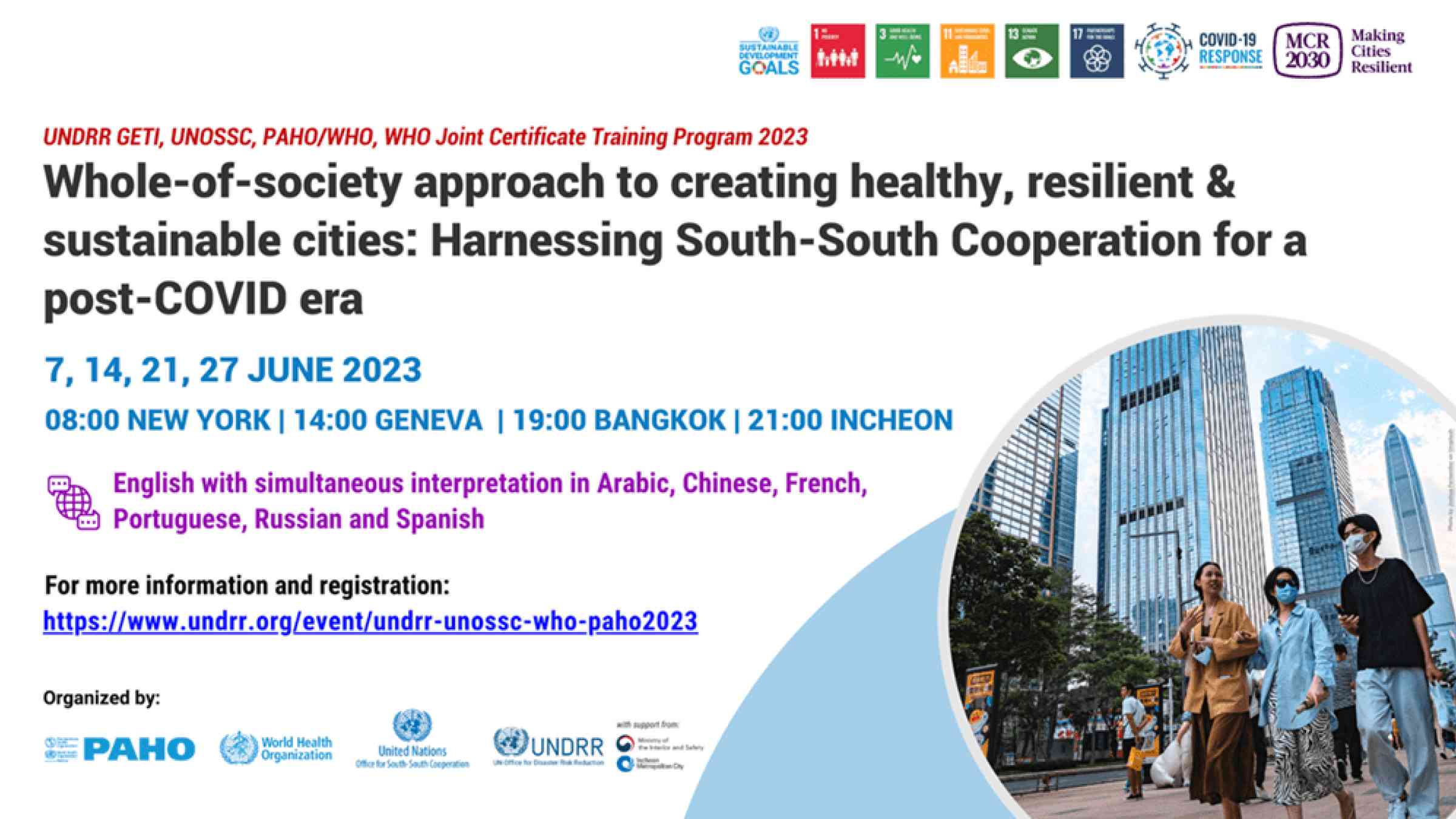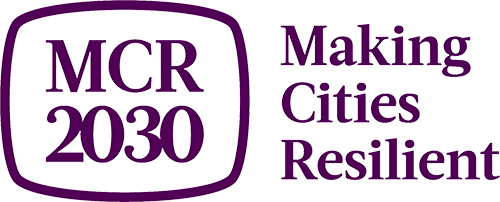[UNDRR GETI, UNOSSC, PAHO/WHO, WHO Joint Certificate Training] Whole-of-society approach to creating healthy, resilient and sustainable cities

- Arabic
- Chinese
- English
- French
- Russian
- Spanish
The recordings of previous sessions are available below.
Time
7, 14, 21, 27 June 2023
08:00 New York | 14:00 Geneva | 19:00 Bangkok | 21:00 Incheon
(Four 90-100 minutes online sessions, one end-of-course exam, and one post-course survey)
Venue
Virtually through UNOSSC Virtual Training platform (Access link will be provided to successfully course registrants only)
Workshop Language
English with simultaneous interpretation in Arabic, Chinese, French, Portuguese, Russian and Spanish
Background
The COVID-19 pandemic has shown the world what climate change has yet to, that prevailing risk governance and risk management architecture, mechanisms and approaches are inadequate when dealing with systemic, interconnected drivers of risks and cascading impacts. It demonstrated the consequences of failing to grasp and manage the drivers of risk creation and propagation in and across sectors, disciplines, geographies, scales and through time which negatively impact the health and well-being of humans and ecosystems and exacerbate vulnerabilities and exposure.(The Report of the Midterm Review of the Implementation of the Sendai Framework for Disaster Risk Reduction 2015-2030)
2023 marks the midpoint in the implementation of the Sendai Framework for Disaster Risk Reduction, the 2030 Agenda and other 2015 agreements which provides a major opportunity for all to review the progress and change course towards sustainable and resilient future for all. The finding from the Mid-term Review of the Sendai Framework reveals that while progress is being made, risk creating is outstripping risk reduction and the progress in risk governance and decentralization of disaster risk reduction (DRR) strategies and implementation at the local level remains a challenge. Collaboration is critical not only with government offices, institutions, or entities responsible for disaster and crisis management, but also with all stakeholders, requiring an all-of-society and all-of-government engagement and partnership for its achievement. Capacity building of local risk management is a key priority that must be supported and guided by the national-level authorities and partners at all levels. It is also highly crucial to ensure inclusivity in DRR governance structure and enable whole-of-society engagement and participation.
The Buenos Aires outcome document of the second High-level United Nations Conference on South-South Cooperation (BAPA+40) in 2019, recognizes that local authorities as well as women and youth, play a growingly indispensable role in South-South and Triangular Cooperation (SSTC) which can take different forms, such as knowledge sharing, training and capacity building, and technology exchange in thematic areas, such as disaster risk mitigation and climate change. BAPA+40 outcome document also places need and importance to promote inclusive societies for achieving sustainable development, and to build effective, accountable, and inclusive institutions at all levels.
According to the UN, as of 2021, the global youth population is estimated to be 1.2 billion (16% of world population) and about 60% of world’s young people live in developing countries. Youth can play significant role in DRR and have the potential to build safer and more resilient communities through, for example, raising awareness on DRR and disaster preparedness and response, advocating for policy changes and better DRR strategies that prioritize the needs and safety of their communities, promoting youth volunteerism in disaster response efforts; developing and utilizing innovative technologies and digital and social media tools that can help in DRR, and serving as a catalyst for community engagement.
Since 2020, UNOSSC, UNDRR GETI, PAHO/WHO and WHO have jointly organized three annual certificate online training programmes focusing on harnessing South-South Cooperation, DRR and integration of health emergency response and preparedness in building resilience cities and societies, responding to different phases of the outbreak, emergency response and recovery of COVID-19 pandemic. The past three annual training series were well attended by over 6000+ participants from 155 countries and territories.
Building on the success of past three training series and learning from the pandemic, the fourth annual training will be organized in June 2023 aiming to provide foundation of thoughts for engaging multi-governments and multi-stakeholders especially most at-risk groups such as women, youth and person with disabilities in DRR and public health emergency response and preparedness. The course emphasizes a whole-of-society approach to managing complex risk and creating healthy, sustainable, and resilient cities with practical examples and useful tools.
Sessions
Session 1
Session 2
Session 3
Session 4
Course Objective
This training serves as an introductory training for urban leaders, planners, and practitioners, aiming to:
- Increase awareness and understanding for managing complex urban disaster risks and enhancing public health emergency response preparedness, and SSTC;
- Introduce useful concepts and tools to strengthen whole-of-society engagement in urban disaster risk management;
- Better prepare city stakeholders and engage them in making cities resilient for future crises, health and non-health emergencies and uncertainties;
- Facilitate learning through SSTC towards sustainable development;
- Inspire and motivate whole-of-society (especially young people) to play a key and active role in securing resilient and sustainable urban futures.
By the end of this training, participants shall be able to:
- Describe the connections between systematic risks, DRR, public health emergency response preparedness, SSTC, and the whole-of-society approach to public health and disaster risk management;
- Apply concepts and tools such as the Disaster Resilience Scorecard for Cities – Public Health System Resilience Addendum to enhance engagement of multi-governments and multi-stakeholders in DRR, health response and preparedness, and SSTC;
- Provide examples of good practices and relevant solutions for multi-stakeholder engagement and participation in DRR, health emergency response preparedness, and SSTC.
Targeted Audience
Local and national government officials in charge of disaster risk reduction and management, urban development and planning and public health emergency preparedness, national associations of municipalities, urban resilience and development practitioners, as well as civil society, private sector, and academia.
Among the focused participants, efforts will be made to mobilize youth including young experts, local government officials and other young stakeholders to raise their awareness on SSTC, DRR, and health resilience issues facing the world globally. An outreach and engagement efforts will be made with universities in the global south, youth networks, and organizations, including with UN agencies such as the Office of the Secretary General’s Envoy on Youth, UNFPA, among others.
The course is open to all applicants from both developed and developing countries, especially young people. Participants from Least Developed Countries (LDCs) and Small Island Developing States (SIDs) are highly encouraged.
No. of Trainees: Maximum 1,000 participants, on a first come first served basis.
Course assessment (exam)
Participants will be given an online voluntary end-of-course exam via the UNOSSC virtual training platform to test their knowledge and understanding of key content taught and presented in the training. The assessment will consist of a quiz to test knowledge on SSTC, DRR and public health. Participants need a score of 80% or above to succeed.
Course evaluation survey
To enable evidence-based course evaluation, a post-course survey will be disseminated to participants to collect feedback on the course content and organization, as well as understanding participants’ development needs for follow-up and to facilitate future programmatic designing.
Certificate
Certificate of completion will be given to participants who meet the following requirements:
- Attend at least 3 out of 4 live sessions (75% attendance)
- Complete a feedback survey, and
- Complete an end-of-course assessment (exam), with a score of 80% or above
Qualified participants who fulfil all requirements can obtain the certificate automatically from the UNOSSC Virtual Training platform.
Disclaimer: For the purpose of this training, UNOSSC and UNDRR procure the services of vFairs LLC and Zoom Video Communications, Inc., which are external service providers. Registration for this training is supported by the vFairs registration mechanism and does not imply the expression of any opinion whatsoever on the part of the Secretariat of the United Nations concerning the legal status of any country, territory, city or area or of its authorities.

